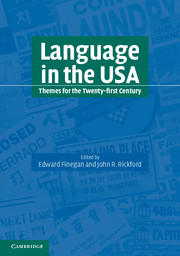Book contents
- Frontmatter
- Contents
- List of figures
- List of tables
- List of contributors
- Acknowledgments
- Foreword
- Editors' preface
- Part 1 American English
- Part 2 Other language varieties
- Part 3 The sociolinguistic situation
- 15 Language ideology and language prejudice
- 16 Ebonics and its controversy
- 17 Language planning, language policy, and the English-Only Movement
- 18 Language in education
- 19 Adolescent language
- 20 Slang
- 21 Hip Hop Nation Language
- 22 Language, gender, and sexuality
- 23 Linguistic identity and community in American literature
- 24 The language of doctors and patients
- 25 The language of cyberspace
- 26 Language attitudes to speech
- Index
18 - Language in education
Published online by Cambridge University Press: 05 June 2012
- Frontmatter
- Contents
- List of figures
- List of tables
- List of contributors
- Acknowledgments
- Foreword
- Editors' preface
- Part 1 American English
- Part 2 Other language varieties
- Part 3 The sociolinguistic situation
- 15 Language ideology and language prejudice
- 16 Ebonics and its controversy
- 17 Language planning, language policy, and the English-Only Movement
- 18 Language in education
- 19 Adolescent language
- 20 Slang
- 21 Hip Hop Nation Language
- 22 Language, gender, and sexuality
- 23 Linguistic identity and community in American literature
- 24 The language of doctors and patients
- 25 The language of cyberspace
- 26 Language attitudes to speech
- Index
Summary
Editors' introduction
This chapter should be read with chapter 17. Both discuss Proposition 227, the anti-bilingual education voter initiative that was approved by 61 percent of the California electorate in 1998, but in this chapter Lily Wong Fillmore comes at it from the focused perspective of the rise (and fall) of bilingual education, complementing the more general perspective of language planning and policy examined in the preceding chapter. Here, the time depth is also more restricted, since, despite early twentieth-century contestations of the assumption that schooling would be provided primarily if not entirely in English, bilingual education was not formally instituted at a federal level until 1968. It was in that year, partly in response to the example of Florida schools in which the children of Cuban immigrants were being successfully instructed in English and Spanish, that the Bilingual Education Act was passed. This chapter traces the developments leading up to this and to the subsequent Lau guidelines of 1975, which further ensured the provision of bilingual education for Limited English Proficient (LEP) students across the USA.
From the beginning there was ideological opposition to bilingual education, however. This chapter documents the increasing debate that would end in the passage of proposition 227 in California and identifies seven “challenges” or charges often raised against bilingual education (e.g., bilingual education programs “are educationally ineffective”) along with counterarguments to each one.
- Type
- Chapter
- Information
- Language in the USAThemes for the Twenty-first Century, pp. 339 - 360Publisher: Cambridge University PressPrint publication year: 2004
- 8
- Cited by



